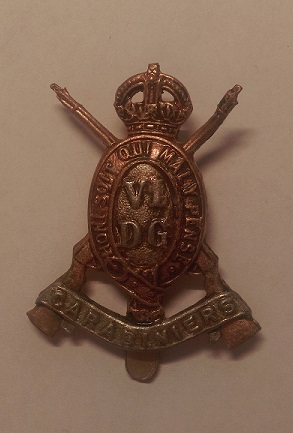Options for Change was a restructuring of the British Armed Forces in summer 1990 after the end of the Cold War.

The 5th Royal Inniskilling Dragoon Guards was a cavalry regiment of the British Army formed in 1922 by the amalgamation of the 5th Dragoon Guards and the 6th (Inniskilling) Dragoons. It served in the Second World War and the Korean War. In August 1992, as a consequence of the Options for Change defence cuts, the regiment was amalgamated with the 4th/7th Royal Dragoon Guards to form the Royal Dragoon Guards.

The 4th Princess Louise Dragoon Guards is an inactive armoured regiment of the Canadian Militia / Canadian Army. It is currently on the Supplementary Order of Battle.

The 3rd Carabiniers (Prince of Wales's Dragoon Guards) was a cavalry regiment of the British Army. It was formed in 1922 as part of a reduction in the army's cavalry by the amalgamation of the 3rd Dragoon Guards (Prince of Wales's) and the Carabiniers (6th Dragoon Guards), to form the 3rd/6th Dragoon Guards. It was renamed the 3rd Carabiniers (Prince of Wales's Dragoon Guards) in 1928 and amalgamated with the Royal Scots Greys (2nd Dragoons), forming the Royal Scots Dragoon Guards (Carabiniers and Greys) in 1971.

The Carabiniers (6th Dragoon Guards) was a cavalry regiment of the British Army. It was formed in 1685 as the Lord Lumley's Regiment of Horse. It was renamed as His Majesty's 1st Regiment of Carabiniers in 1740, the 3rd Regiment of Horse (Carabiniers) in 1756 and the 6th Regiment of Dragoon Guards in 1788. After two centuries of service, including the First World War, the regiment was amalgamated with the 3rd Dragoon Guards (Prince of Wales's) to form the 3rd/6th Dragoon Guards in 1922.
The British Army is listed according to an order of precedence for the purposes of parading. This is the order in which the various corps of the army parade, from right to left, with the unit at the extreme right being highest. Under ordinary circumstances, the Household Cavalry parades at the extreme right of the line. Militia and Army Reserve units take precedence after Regular units with the exception of The Honourable Artillery Company and The Royal Monmouthshire Royal Engineers.

The 4th Royal Irish Dragoon Guards was a cavalry regiment in the British Army, first raised in 1685 as the Earl of Arran's Regiment of Cuirassiers. It was renamed as the 4th Dragoon Guards in 1788 and service for two centuries, including the First World War, before being amalgamated with 7th Dragoon Guards, to form the 4th/7th Dragoon Guards in 1922.

The 5th Dragoon Guards was a British army cavalry regiment, officially formed in January 1686 as Shrewsbury's Regiment of Horse. Following a number of name changes, it became the 5th Regiment of Dragoon Guards in 1804.

The 6th (Inniskilling) Dragoons was a cavalry regiment in the British Army, first raised in 1689 as Sir Albert Cunningham's Regiment of Dragoons. One of the regiment's most notable battles was the Battle of the Boyne in July 1690. It became the 6th (Inniskilling) Regiment of Dragoons in 1751. The regiment also fought with distinction in the Charge of the Union Brigade at the Battle of Waterloo and again as part of the successful Charge of the Heavy Brigade against superior numbers at the Battle of Balaclava during the Crimean War. The First World War sounded the death knell for mounted cavalry as it became apparent that technology had moved forward with greater destructive power and made horsed cavalry redundant on the modern battlefield. The British Army reorganised and reduced its cavalry corps by disbanding or amalgamating many of its famous cavalry regiments. The Inniskillings was one of those affected. It saw service for two centuries, including the First World War, before being amalgamated with 5th Dragoon Guards to form 5th/6th Dragoons in 1922.

The regimental depot of a regiment is its home base for recruiting and training. It is also where soldiers and officers awaiting discharge or postings are based and where injured soldiers return to full fitness after discharge from hospital before returning to full duty. Normally, a variety of regimental stores will also be kept at the depot. The regimental depot is not the same as the regimental headquarters, though in practice the two will often be co-located in the same place.
During the First World War the British Armed Forces was enlarged to many times its peacetime strength. This was done mainly by adding new battalions to existing regiments. Although sometimes identified by shoulder titles, generally the new battalions could not be identified from appearance. Consequently, the units in this list have been assembled considering only those as having a uniquely different cap badge.
The First World War British Cavalry Corps was formed 9 October 1914.

Raglan Barracks is a military installation at Barrack Hill in Allt-yr-yn in Newport, Wales.
The Princess Louise Dragoon Guards was a heavy cavalry regiment of the Non-Permanent Active Militia of the Canadian Militia. First formed in 1872 as an independent cavalry troop, in 1903 it became a full regiment. In 1936, the regiment was amalgamated with the 4th Hussars of Canada to become the 4th Princess Louise Dragoon Guards.









